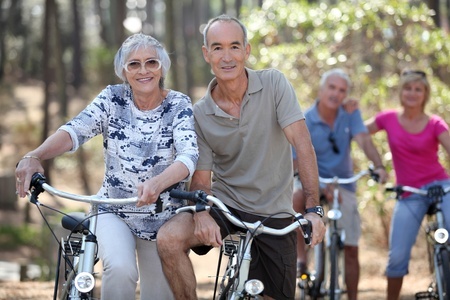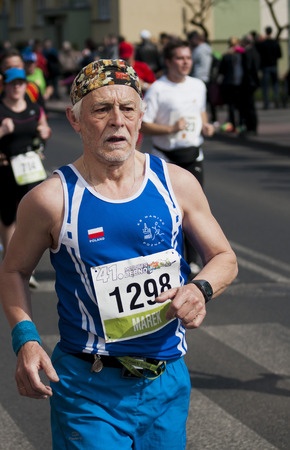
Sarcopenia is the loss of skeletal muscles as we age and this affects our overall strength and performance. This is translated into the inability to perform regular tasks which are necessary for daily living. A person suffering from sarcopenia may need walking aids, would suffer from poor strength of muscles, and start fearing mobility challenges like stairs or stepping on a bathtub; some would be very unsteady on uneven terrains such as rocky backyard to grass lawn to sandy beach because of the risk of imbalance and falls. They resort to the safety of a stable structure like a rail, a tree trunk or someone to hold on. You see them in the airports looking healthy but could hardly walk a certain amount of distance.
Sarcopenia occurs much later in life, most likely after the age of 70. There is a difference between sarcopenia and disability and those who fake weakness LOL. I am often amused by those who can run and jump in real life but suddenly require a scooter in Publix or a wheelchair in airports. If you ask me, I will rather walk as much as I can, even parking far from the entrance of malls, or Walmart or Publix. There is nothing more beautiful than rising up from sitting and taking steps no matter how slow. The ability to move is a gift from God and I don’t know why some would like to immobilize themselves. Some healthy people or those with very minor limitations try desperately to obtain a disabled parking permit. What is the idea? I mean, I can walk 5 miles in one sitting and why would I all of a sudden be so desperate to make a quick zip line to the grocery store? I am not generalizing. I just know some people who are like that. Obviously, there are exemptions. Buying bulky items and furniture would make sense to park closest to the entrances of stores. But ordinary shopping should encourage a healthy lifestyle among people by walking longer in good weather.
Especially when retired with extra time. Why not take the scenic route? I park a safe distance from any store so I can take extra steps.
I live downtown and when the traffic is slow, I walk from my house to the beach. Some people walk their dogs. Some walk back and forth in their gardens. Some walk in parks and chat with friends and strangers and neighbors increasing their networks and sociability. That improves mental health (if that is your thing). Some retirees volunteer in local facilities like hospitals and churches to allow them to frequently sit and stand. There is nothing wrong with greeting and directing people especially if it lifts the spirit and burns calories.
There is a catch though. Mobility like walking is healthy cardiovascular but Sarcopenia weakens muscles also. Conventional wisdom states that as we get older, we need to combine cardiovascular and muscular strength. The strength of the muscles is reduced at a rate of 3% per year after middle age. That is a reduction in volume and mass. It is atrophy but it isn’t demonstrated because what makes up for the lost mass volume is fats. That fat within the muscles reduces metabolism and affects things like speed, endurance and balance.
So it is imperative that a good workout would include cardiovascular training for endurance and muscle training for strength. Both needed to reduce the functional and safety decline in aging.
Then the question is when do you do cardio and when do you do strength? Do you do them separately or at the same time (meaning in the same session). There are studies done on this and they all agree that doing them together in a single session is counterproductive, it seems one cancels the other. In other worlds the buildup of endurance may reduce the buildup of strength. The evidence suggests that endurance one day and strengthening on another day may be the best exercise program to achieve both.
What is endurance? It is the ability to perform light tasks, like walking, cooking, gardening, showering, and light household cleaning for a long time before experiencing tiredness. Strength on the other hand is the amount of effort exerted by the muscles to perform a usually short duration task. Such as lifting an object, standing from sitting, getting out of bed, picking up an object from the ground, countering an abrupt loss of balance, maintaining balance (balance is an interplay of many muscles in the body).
Lean forward (with extra care of course) and you will observe and feel different groups of muscles acting together to correct your lean. Standing on one leg, such as putting on your pants, would suddenly recruit a lot of muscles in the body to maintain your balance. Sit on a therapeutic ball and you would feel the tension in your core as your trunk muscles simultaneously contract to maintain a midline posture. This is a factor one should consider as one ages. If one focuses exclusively on cardiovascular endurance without strengthening, there is a high risk of falling and injury. If one focuses exclusively on strengthening, medical problems such as high blood pressure, high cholesterol, blood sugar etc. may not be addressed.

It goes without saying there are many arguments over this. The strengthening proponents claim that strengthening can be altered to impact the cardiovascular while the cardiovascular proponents claim the same with endurance exercises.
Circuit training is an example of both cardio and strengthening programs. If you advance your endurance exercise up to speed, such as a quick turnover of your legs, carrying weights in both arms, or both legs, running on ramps or elevations, speeding your bicycle up a hill or mountain, stairs are considered both endurance and strengthening exercises. High-Intensity Interval Training that are short spurt but high-impact routine for HIIT such as:
- Burpees
- Mountain Climbers
- Sprints
- Tuck Jumps
- High Knees
- Lateral Lunges with Hops
- Box Jumps
Can be structured to increase strength and endurance if done correctly. But I am getting outside of the Sarcopenia topic here. HIIT may be good, how but I am not sure how many ordinary senior citizens can work this out. It would probably require lots of modifications. A debilitated person might invite more injuries if these HIIT programs are attempted. There are always exceptions, but it might be more prudent to have a professional exercise coach who is familiar with the limitations of old age get you started first.
There are evidence-based studies which also show that combining endurance and strengthening in the same session is counter-productive. Since sarcopenia and old age lessen the mass and strength of muscles, it is important to separate the two goals on separate days. In my case, I do a minimum of three days cardio and two days strengthening per week. I incorporate rest and relaxation on non-workout days.
Resources:
TWENTY-FOUR MONTHS’ RESISTANCE AND ENDURANCE TRAINING IMPROVES MUSCLE SIZE AND PHYSICAL FUNCTIONS BUT NOT MUSCLE QUALITY IN OLDER ADULTS REQUIRING LONG-TERM CARE, A. YOSHIKO, T. KAJI, H. SUGIYAMA, T. KOIKE, Y. OSHIDA , H. AKIMA (authors), Journal of Nutrition, Health and Aging 2019
PHYSICAL ACTIVITY - DECISIVE FACTOR FOR FULL LIFE OF PEOPLE IN AGE, Valentina Vassileva (author), Activities in Physical Education and Sport 2015, Vol. 5, No. 2, pp. 214-217
THE EFFECTS OF UPPER BODY STRENGTH TRAINING VERSUS CONCURRENT STRENGTH + ENDURANCE TRAINING ON INDICES OF STRENGTH, AEROBIC POWER, AND MUSCLE CROSS SECTIONAL AREA, Jose Antonio (author), Nova Southeastern University, Fight Science Lab, Exercise and Sport Science, Davie Florida USA 33328, Journal of Exercise Physiologyonline August 2023 Volume 26 Number 4